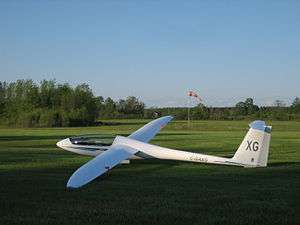PZL Bielsko SZD-55
The PZL Bielsko SZD-55 Nexus is a Standard Class sailplane produced by PZL Bielsko since 1988. It was built in direct competition with the Schempp-Hirth Discus. The SZD-55 is still in production with approximately 110 built.
| SZD-55 | |
|---|---|
 | |
| An SZD-55 at SOSA Gliding Club, Rockton Airport | |
| Role | Standard-class sailplane |
| National origin | Poland |
| Manufacturer | PZL Bielsko |
| Designer | mgr inż. Tadeusz Łabuć |
| First flight | 15 August 1988 |
| Introduction | 1988 |
| Status | in production |
| Number built | ~110 |
| Developed from | SZD 48M "Bravo" |
Design and development
The SZD-55 is built of fiberglass and has an elliptical wing. It has top surface Schempp-Hirth type airbrakes. It is a glider with pleasant handling [1] that is easy to assemble, due to automatic controls hookup. With an empty weight of about 215 kg, it is the lightest of the current standard class gliders and is known for its excellent climbing and thermalling characteristics.[2] The SZD-55 has a fairly cambered wing-section and performs well at lower speeds, but with plenty of water ballast (it can take 200 liters) it can also keep up well at higher speeds.
Main designer of the SZD-55 was Tadeusz Łabuć. Since the mid-eighties, the best glider in the standard class was undoubtedly the German standard Discus, whose excellent performance was attributed to its unusual triple trapeze wing shape. So it was logical to adopt a similar idea for use of this outline of the new construction: the elliptical contour of the wing leading edge. Documentation of the glider was developed in 1987 same as prototypes for factory numbers X-144 (SP-P501) and X-145 (SP-P502) and flew 15.08.1988 and 03.01.1989 by January Roman.
Despite enormous difficulties in obtaining advanced materials (carbon fabric, kevlar) and the need for glass-epoxy laminates, the manufacturer managed to create a glider with an unladen weight of just over 200 kg. Klaus Holighaus, one of the finest manufacturers of gliders (Nimbus and Discus family) stated that if using a fiberglass technology PZL Bielsko factory reached less weight than gliders constructed using carbon fiber and Kevlar that means that they developed a new technology.[3] This technology was later improved upon during the design and building of the SZD-56 Diana.
Specifications
Data from http://szd.com.pl/downloads/4e66270921313szd-55-1-en.pdf SZD Allstar
General characteristics
- Crew: 1
- Length: 6.85 m (22 ft 6 in)
- Wingspan: 15.00 m (49 ft 3 in)
- Height: 1.47 m (4 ft 10 in)
- Wing area: 9.60 m2 (103.3 sq ft)
- Aspect ratio: 23.44
- Airfoil: NN-27, modified
- Empty weight: 215 kg (474 lb)
- Max takeoff weight: 500 kg (1,102 lb)
Performance
- Stall speed: 63–84 km/h (39–52 mph, 34–45 kn) at 275-500kg
- Never exceed speed: 255 km/h (158 mph, 138 kn) in smooth air
- g limits: +5.3 -2.65
- Maximum glide ratio: 44
- Best glide speed: 90–119 km/h (49–64 kn; 56–74 mph)
- Rate of sink: 0.48–0.68 m/s (94–134 ft/min)
- Minimum sink speed: 75–100 km/h (40–54 kn; 47–62 mph)
- Wing loading: 28.5–52.1 kg/m2 (5.8–10.7 lb/sq ft)
References
| Wikimedia Commons has media related to SZD-55. |
- Polskie Szybowce 1945-2011 Problemy rozwoju - ISBN 978-83-932826-0-9
- Polskie Szybowce 1945-2011 Problemy rozwoju - ISBN 978-83-932826-0-9
- Polskie szybowce 1945-2011 - Problemy rozwoju - ISBN 978-83-932826-0-9